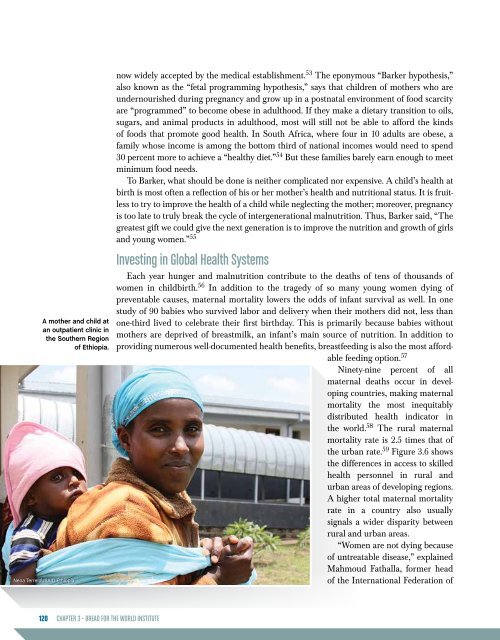THE NOURISHING EFFECT
HR2016-Full-Report-Web
HR2016-Full-Report-Web
Create successful ePaper yourself
Turn your PDF publications into a flip-book with our unique Google optimized e-Paper software.
A mother and child at<br />
an outpatient clinic in<br />
the Southern Region<br />
of Ethiopia.<br />
Nena Terrell/USAID Ethiopia<br />
now widely accepted by the medical establishment. 53 The eponymous “Barker hypothesis,”<br />
also known as the “fetal programming hypothesis,” says that children of mothers who are<br />
undernourished during pregnancy and grow up in a postnatal environment of food scarcity<br />
are “programmed” to become obese in adulthood. If they make a dietary transition to oils,<br />
sugars, and animal products in adulthood, most will still not be able to afford the kinds<br />
of foods that promote good health. In South Africa, where four in 10 adults are obese, a<br />
family whose income is among the bottom third of national incomes would need to spend<br />
30 percent more to achieve a “healthy diet.” 54 But these families barely earn enough to meet<br />
minimum food needs.<br />
To Barker, what should be done is neither complicated nor expensive. A child’s health at<br />
birth is most often a reflection of his or her mother’s health and nutritional status. It is fruitless<br />
to try to improve the health of a child while neglecting the mother; moreover, pregnancy<br />
is too late to truly break the cycle of intergenerational malnutrition. Thus, Barker said, “The<br />
greatest gift we could give the next generation is to improve the nutrition and growth of girls<br />
and young women.” 55<br />
Investing in Global Health Systems<br />
Each year hunger and malnutrition contribute to the deaths of tens of thousands of<br />
women in childbirth. 56 In addition to the tragedy of so many young women dying of<br />
preventable causes, maternal mortality lowers the odds of infant survival as well. In one<br />
study of 90 babies who survived labor and delivery when their mothers did not, less than<br />
one-third lived to celebrate their first birthday. This is primarily because babies without<br />
mothers are deprived of breastmilk, an infant’s main source of nutrition. In addition to<br />
providing numerous well-documented health benefits, breastfeeding is also the most affordable<br />
feeding option. 57<br />
Ninety-nine percent of all<br />
maternal deaths occur in developing<br />
countries, making maternal<br />
mortality the most inequitably<br />
distributed health indicator in<br />
the world. 58 The rural maternal<br />
mortality rate is 2.5 times that of<br />
the urban rate. 59 Figure 3.6 shows<br />
the differences in access to skilled<br />
health personnel in rural and<br />
urban areas of developing regions.<br />
A higher total maternal mortality<br />
rate in a country also usually<br />
signals a wider disparity between<br />
rural and urban areas.<br />
“Women are not dying because<br />
of untreatable disease,” explained<br />
Mahmoud Fathalla, former head<br />
of the International Federation of<br />
120 CHAPTER 3 • BREAD FOR <strong>THE</strong> WORLD INSTITUTE


